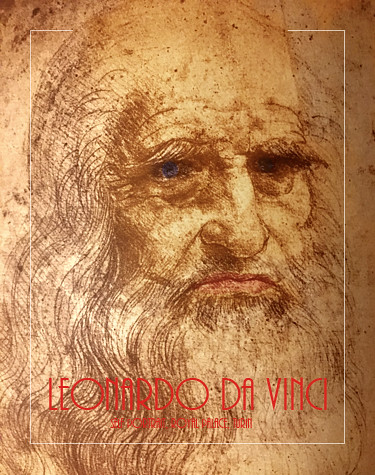
Volume XVI, Issue II: GENIUS: Leonardo da Vinci
The GENIUS of Leonardo da Vinci
He was born in April of 1452, the son of Notary Piero da Vinci and a peasant woman, Caterina. His birth, being illegitimate, might have sentenced him to a life of obscurity, as he could not pursue the professional path of his father. But in these days artists were considered ‘tradesmen,’ with their own guild and Piero apprenticed his son to the painter Andrea del Verocchio, who would teach him. Eventually young Leonardo’s inquisitive spirit led him to go far beyond his training. He actually had no formal academic training, yet he would use his keen abilities of observation to become, largely self taught, the personification of the Renaissance Man. He was a true polymath, who in stretching the profession of painting expanded knowledge in optics, engineering and biology. Art Historian Helen Gardner calls his a “feverishly inventive imagination.”
Assistants often painted the backgrounds of great masterpieces. Verrochio painted The Baptism of Christ and Leonardo added an angel holding Jesus’s robe to the composition that was so far superior to the work of his master that it is said that Verocchio “put down his brush and never painted again.” Today art experts can clearly see the hand of Leonardo in the landscape details in the background as well as in the face of the young angel. In 1472 Leonardo joined the Guild of Saint Luke – the guild of artists and practicers of medicine. He continued in the service of Verrochio after that. In 1481 he was directly in the service of the ruling Medici, receiving a commission for an altarpiece The Adoration of the Magi. Though a sublime painting, it was never finished! Leonardo brought it “right up to the brink” and left off, much to the displeasure of his patrons.
Fifteenth Century Florence was a world in upheaval and the political and societal events of that time would both shape and buffet the career of Leonardo. He served Verocchio long after his apprenticeship period ended, though he was already recognized as a superior talent. He was a perfectionist, often studying a partially completed work for hours on end. His inability to produce work rapidly led him to have difficulty with his patrons. Passed up by the Florentine Medici for further lucrative commissions, he went into the service of Ludovico Sforza, the Duke of Milan. Milan, being the Northernmost City State in Italy was the most exposed to invasion. Leonardo designed many machines of war but seems chiefly to have been engaged in producing elaborate stage sets for the many balls and celebrations enjoyed by the Sforza women. In the movie Ever After, an elaborate masked ball, orchestrated by Leonardo, is depicted. This is probably a pretty good representation of the type of projects he was engaged in.
He prepared sketches and models for a great equestrian statue of Ludovicio’s predecessor, Francesco Sfoza, that was never executed. But his first truly great work was realized when he was asked to paint The Last Supper in the refectory of the Monastery of Santa Maria delle Grazie. When Ludovicio Sforza was overthrown by the French in 1500, he went to Venice where he was employed as a military engineer. He returned to Florence and in 1502 he left and entered the service of Cesare Borgia as a military engineer. In 1503 he returned to Florence and it was here that he began work on his Portrait of Lisa del Giocondo, eventually the model for the Mona Lisa. He would work on that painting for the rest of his life.
In 1516 Leonardo entered the service of Francis I, king of France (the period depicted in the movie Ever After). In 1517 it appears that Leonardo experienced the loss of the use of his right hand. He died in May of 1519 at the age of 67, possibly from a stroke. The King of France is said to have considered the painter a close friend. As he lay dying, Leonardo was full of repentance, saying that “he had offended against God and man by failing to practice his art as he should have done.” He sent for a priest and made confession before receiving the Eucharist. It is believed that King Francis cradled the painter’s head in his arms as he departed this life. Leonardo da Vinci left a legacy of observation, innovation and accomplishment which inspires us to this day!
Studies for The Last Supper

Study for the head of Phillip.
Leonardo da Vinci was a master of the art of observation, sketching all manner of people to create his paintings. It is said that he pretty easily found eleven of the models pretty quickly but was having trouble finding just the right Judas and Jesus. For Judas, he headed to the seedy side of Milan where criminals were known to abound. Eventually he found the strong features for the betrayer. For Christ, he attempted to visit the other extreme and sketched some of the young nobles of the city before backing off and creating the expressionless face of one fully human and fully Divine.

Study for the head of Jesus.

Study for the Head of Judas.

The Last Supper by Leonardo da Vinci.
The Mona Lisa

Leonardo da Vinci's sfumato technique gives soft blending to the painting and perhaps adds to its mystery.
